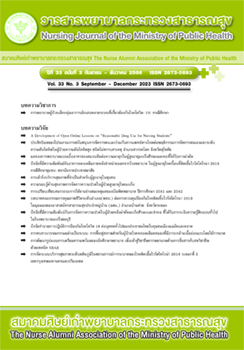Factors Related to Pain Management in Patients with Head and Neck Cancer Undergoing General Anesthesia in Chonburi Cancer Hospital
Main Article Content
Abstract
Pain is an unpleasant experience, especially postoperative pain. When pain is managed appropriately, it has a beneficial effect on the healing process and allows for rapid recovery. The purpose of this study was to examine factors associated with pain management in patients following head and neck cancer surgery with general anesthesia. The sample consisted of 85 head and neck cancer patients undergoing surgery and general anesthesia in Chonburi Cancer Hospital. Patients were selected according to the specified criteria. Data were collected between October 2020 and April 2022. The research instruments consisted of 1) personal information including age, duration of surgery, 2) pain 3) satisfaction, and 4) pain management. The reliability value of the instruments 3-4 were .95 and .83, respectively. Data were analyzed using descriptive statistics and correlation coefficient statistics. The research results showed that the mean age of the sample was 57.7 years (SD=1.26). The average surgery time was 179.27 minutes (SD=9.16). The postoperative pain level was at a level of 4 to6 points. The level of personnel satisfaction with pain management was high. The level of satisfaction with pain management of personnel was moderately related to pain management of patients (r = .50, p<.001). These research findings are beneficial to medical personnel as they can be used as guidelines for organizing activities or programs to improve knowledge and skills in the care of cancer patients with postoperative pain to help patients manage pain appropriately and efficiently.
Article Details

This work is licensed under a Creative Commons Attribution-NonCommercial-NoDerivatives 4.0 International License.
บทความและรายงานวิจัยในวารสารพยาบาลกระทรวงสาธารณสุข เป็นความคิดเห็นของ ผู้เขียน มิใช่ของคณะผู้จัดทำ และมิใช่ความรับผิดชอบของสมาคมศิษย์เก่าพยาบาลกระทรวงสาธารณสุข ซึ่งสามารถนำไปอ้างอิงได้
References
Pommala W, Khamsimbat N, Tunukoon S, Wongsaree C, Yuenyong N. Pain management through prayer. Pathumthani University Academic Journal. 2021; 13(2): 574-84.(in Thai)
Saeangchai J, Piyasut C, Kaewkulpat S. Multimodal pain management: goal setting for postoperative pain. boromarajonani college of nursing, Uttaradit Journal 2019; 11(2): 161-171.(in Thai)
Sawangsri K. Pain management in patients undergoing open heart surgery. Thai Journal of Cardio-Thoracic Nursing 2017; 28(1): 2-15.(in Thai)
Maciel HIA, Costa MF, Costa ACL, Marcatto JO, Manzo BF, Bueno M. Pharmacological and nonpharmacological measures of pain management and treatment among neonates. Revista Brasileirade terapia intensive.2019; 31(1): 21–26. https://doi.org/10.5935/0103-507X.20190007
Khemla, W. of clinical nursing practice guidelines for pain management in the elderly with hip arthroplasty. The Journal of Faculty of Nursing Burapha University 2020; 28(2); 1-15.(in Thai)
Chuautsaha W; The Development of clinical nursing practice guideline for postoperative abdominal surgical pain patient at Banpong hospital Ratchaburi province. [mater thesis] Nakhonprathom : Christan Uninesith. (in Thai)
Roy C, Andrews. HA. The Roy’s Adaptation Model. (2nded.), Stamford: Appleton & Lange. 1999.
Cohen JM, Uphoff NT. Rural development participation: concept and measure for project design implementation and evaluation: rural development committee center for international studies. New York: Cornell University Press. 1981.
Janphete N. Study of pain management and satisfaction in postoperative patients receiving general anesthesia in the recovery room, Nopparat Rajathanee Hospital. Journal of Bamrasnaradura Infectious Diseases Institute 2019;13(1):13-22.(in Thai)
Watthanatanyakarn D, Sumdaengrit B, Kanoksuntornrut N. The evaluation of pain management guideline in patients with orthopedic surgery. Journal of Nursing and Health Care 2018;36(4):100–9.(in Thai)

